My 18-year-old daughter will depart for college next fall, and every time she leaves the house with the salutation, “See ya, Pops!” I cringe a little. I know the day will come all too soon when I will hear it with more finality in her voice.
The recent plummet in oil prices is also causing everyone in the sector to cringe. The synchronous dive in NGL pricing has caused the all-important fractionation (frac) spread to evaporate.
During the last six years, the strength of that spread caused some analysts to refer to the period as “The Golden Age of Natural Gas Processing.” The winners (if any) and losers in this new pricing world are still being determined by analysts who are burning the midnight oil—thank God for their incremental demand.
Questions?
To the uninitiated, many questions arise. What is a frac spread? What are POP (percent of proceeds), keep-whole and fee-based natural gas processing contracts? How long will the frac spread be gone and when might it recover?
The frac spread is the value of the NGL—ethane, propane, butane, isobutane and natural gasoline—less the price of natural gas required to make up for the Btus extracted in a process known as fractionation. If frac spreads are positive, the liquids contained in the raw natural gas are more valuable as NGL and the producer/processor will maximize liquid recovery. If frac spreads are negative, the liquids contained in the gas are less valuable than gas and the producer/processor will minimize liquid recovery. Each NGL component has its own frac spread.
A POP contract is used when the producer receives a predetermined percentage of the recovered gas liquids plus 100% of the remaining residue gas.
A keep-whole contract is used when a producer receives 100% of the Btu value of the natural gas originally delivered to the processor, and the processor keeps 100% of the NGL extracted from the processed gas and purchases natural gas to replace the Btu value of the extracted gas liquids.
A fee-based contract is an agreement where the producer pays the processor a fee, and the producer receives 100% of the recovered NGL plus 100% of the residue gas, less “shrink” of the missing NGL and fuel used.
Admittedly, the midstream industry has shifted away from the POP and keep-whole contract world in favor of more predictable and less volatile fee-based arrangements. But many POP contracts and life-of-lease dedications still exist in the older producing basins such as Texas’ Permian Basin or Colorado’s Denver-Julesburg Basin. The newer, shale-revolution producing areas for the most part rely on fee-based processing.
Under today’s NGL price environment, there is no financial incentive to fractionate NGL from the wet gas stream. It costs more to separate them out than to leave them in the mix of wet gas. The producers’ age-old favorite natural gas processing POP contract has turned sour. Is it then also time to say, “See ya, Pops?”
The important thing to remember here is that any entity that was relying on the value of NGL will continue to suffer economically. Obviously the degree, depth and duration of that pain will depend on the individual companies’ exposure.
It is critical for the industry to understand and admit that midstream gas processing is a must-run industry. It is not in the best interest of E&P companies to have unprofitable or failing gas processors. If processing companies fail, how do E&P companies get gas to market? Should minimum payments to processors be considered to carry a processor through difficult times?
The future
Nearly every MLP has seen its unit price drop in reaction to the oil price decline. The markets presumed that they were all guilty of having a portfolio of POP or keep-whole contracts with a corresponding exposure to the NGL prices.
One midstream company executive recently told me his company had to call most of the analysts covering the company’s stock and reiterate that the company had converted its POP contract exposure with producers and replaced them with fee-based processing arrangements.
Evidently it’s up to the industry to disprove the negative to stock analysts. We should have seen and accepted that burden when we saw the recent meager midnight oil consumption numbers.
And finally on the question of when the frac spread might recover? No one really knows, but by my own midnight oil calculations it will be Feb. 29, 2017, at 2 p.m. Eastern time, give or take.
John Harpole is senior advisor and an editorial advisory board member to Midstream Business. He is founder and president of Mercator Energy LLC and can be reached at jharpole@hartenergy.com or 303-825-1100.
Recommended Reading
Range Resources Holds Production Steady in 1Q 2024
2024-04-24 - NGLs are providing a boost for Range Resources as the company waits for natural gas demand to rebound.
EQT Sees Clear Path to $5B in Potential Divestments
2024-04-24 - EQT Corp. executives said that an April deal with Equinor has been a catalyst for talks with potential buyers.
Novo II Reloads, Aims for Delaware Deals After $1.5B Exit Last Year
2024-04-24 - After Novo I sold its Delaware Basin position for $1.5 billion last year, Novo Oil & Gas II is reloading with EnCap backing and aiming for more Delaware deals.
Matador Hoards Dry Powder for Potential M&A, Adds Delaware Acreage
2024-04-24 - Delaware-focused E&P Matador Resources is growing oil production, expanding midstream capacity, keeping debt low and hunting for M&A opportunities.
TotalEnergies, Vanguard Renewables Form RNG JV in US
2024-04-24 - Total Energies and Vanguard Renewable’s equally owned joint venture initially aims to advance 10 RNG projects into construction during the next 12 months.





